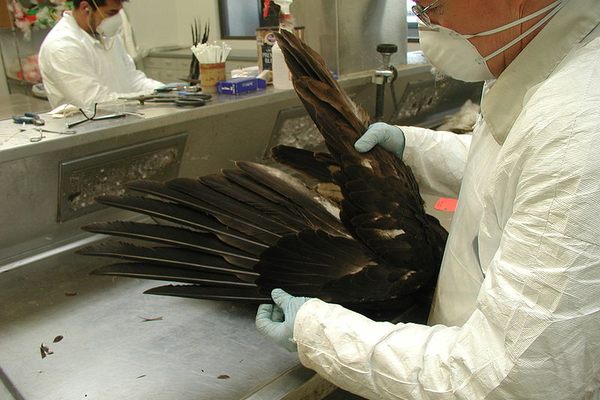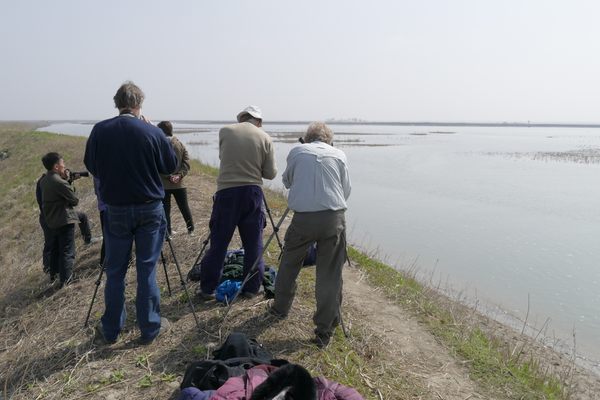How to Make Your Dead Eagle a Legal Eagle
It’s a crime to possess eagle parts. So what should you do if you find some?

Here is a strange-but-true American fact: It is a crime to be in possession of eagles and eagle parts other than for the purposes of Native American tribal ritual—down to a feather.
But, you may be asking, what if I just happen to come across a dead eagle in the wild?
Good question! This is where the National Eagle Repository, the federal government’s official dead eagle processing center, comes in.
Part of the Rocky Mountain Arsenal National Wildlife Refuge near Denver, Colorado, the National Eagle Repository is the one place in the nation where deceased symbols of American freedom are sent, as well as the place you can look to for all your legal eagle part needs.
First created in the 1970s, the office as it exists today was established in 1995 as a result of a presidential mandate designed to create a legally regulated method for Native American tribes to obtain eagle parts for use in various cultural activities. The fierce protection of bald eagles in America made the procurement of eagle parts a thorny issue for many Native American tribes who use them—especially the feathers—in their legally protected cultural rites. With the repository in place, obtaining eagle parts is now a perfectly legal process that both helps to protect the animal and the rights of the people who use them.

The late eagles themselves can flow to the Repository from a number of avenues. According to Coleen Schaefer, the Supervisory Wildlife Repository Specialist, eagle corpses usually come from state and federal wildlife officers who find the dead birds in the wild, as well as eagle rehabilitators who end up with birds that just couldn’t pull through. However, zoos and even private citizens may (and, technically, are legally obligated to) send eagles to the facility. While the website calls for all eagle parts, regardless of condition, to be sent to the repository, Schaefer says they mainly get whole eagles. The Repository is refreshingly nondiscriminatory in its desire for dead eagle parts, although, as their website also makes very clear, they should not be sent eagles that have died from the West Nile Virus. This, tragically, is a real problem.
Birds that have been poisoned are also problematic, as the Repository only accepts them after an necropsy has been performed, just as if they were human murder victims.
Schaefer says that in addition to the more standard cases in which the birds die of disease or some other natural cause, they also get birds that were killed in illegal shootings. Once the investigation is complete, the “victim” is shipped to the Repository to be necropsied and harvested for Native American rituals. Sometimes they even come in still carrying their last meals. “We have received eagles where prey are still gripped in their talons, e.g. fish, ducks, etc., and that’s always interesting,” says Schaefer.

The National Eagle Repository may not be picky about what birds come to them, but they are incredibly fastidious about the parts they send out to others. When the eagles come to the Repository, they are assessed for their usability to the Native American population, as damaged parts are not acceptable for many of their uses. Schaefer estimates that between 30 and 40 eagles are evaluated each day. “If the bird is best suited to be used for feathers, we hand-pluck the feathers from the wings and tail to provide to the applicant,” she says. (Usable or not, that is a staggering amount of dead eagles, and there are only three staff members working on the eagles full-time.)
If you happen to come across a dead eagle, you should contact a wildlife officer. But in case you decide to take care of that national treasure corpse yourself, the Repository suggests that you wear gloves to protect yourself from disease, place the bird in a sturdy plastic bag to prevent “leakage,” and get it into a freezer as soon as possible. All good rules for handling any dead thing, really.
They also suggest that you transport the carcass in a separate area from yourself in a vehicle. Specifically, the back of a pick-up. During both handling and packaging the eagle, it’s important to remember to be extra careful with the feathers, because if they are damaged, your grimly patriotic submission may all have been for naught.
This story originally ran on July 2, 2015.
















Follow us on Twitter to get the latest on the world's hidden wonders.
Like us on Facebook to get the latest on the world's hidden wonders.
Follow us on Twitter Like us on Facebook